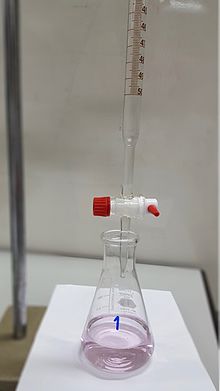
Back Titrasie Afrikaans معايرة (كيمياء) Arabic Titrimetrik analiz Azerbaijani Titrasyon BCL Титриметричен анализ Bulgarian টাইট্রেশন Bengali/Bangla Titracija BS Valoració química Catalan سەنگاندن CKB Titrace Czech

Titration (also known as titrimetry[1] and volumetric analysis) is a common laboratory method of quantitative chemical analysis to determine the concentration of an identified analyte (a substance to be analyzed). A reagent, termed the titrant or titrator,[2] is prepared as a standard solution of known concentration and volume. The titrant reacts with a solution of analyte (which may also be termed the titrand[3]) to determine the analyte's concentration. The volume of titrant that reacted with the analyte is termed the titration volume.
© MMXXIII Rich X Search. We shall prevail. All rights reserved. Rich X Search